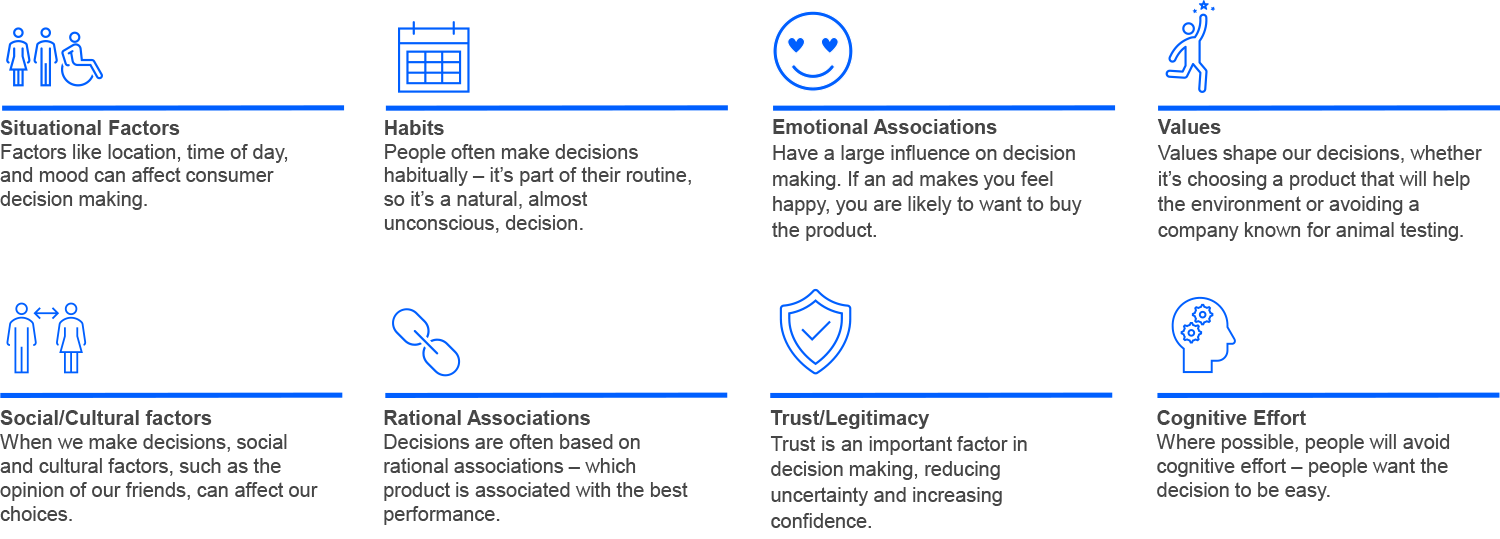As Dr Nicki Morley discusses in her article Why is Innovation so important for brand growth?, disruptive times demand a new approach to innovation. Data from Kantar BrandZ shows that, in difficult times, brands that continue to innovate grow seven times faster than competitors. But the truth is that innovation is an inherently risky business, made even riskier when you don’t take account of human nature and the influence of context throughout the innovation process.
Why context is key for innovation
Context can have a huge, overriding effect on people’s decision making, so companies cannot afford to innovate in a vacuum. Behavioural science – from cognitive psychology, to behavioural economics, to social psychology – offers a framework to understand the impact that context and cues have on people’s decision making. The greatest innovation in the world will fail if it is not tailored to the context in which it will be used.
How to drive successful innovation
Successful innovation demands far more than just new technology – otherwise Google Glass should have been a stunning success.
Instead, people hesitated before adopting it. Why? Because the key influences on consumer decision making – such as social factors and emotional associations – weren’t considered. The behavioural changes needed were underestimated – the sight of someone wearing the glasses triggered privacy concerns for some people, others felt wearing a smart phone on your face made you look odd and stand out. Ultimately the negative frictions outweighed the positive motivations.
Understanding the role of behavioural science in market research could have helped deliver a more successful adoption. At Kantar, we’ve identified eight broad influences on decision making that dictate the likely success of any innovation. Each one can act as either a fuel or a friction to adoption.
Eight influences on decision making
If you know the barriers to adoption, you can craft interventions to overcome them. Google Glass failed because it didn’t address social and cultural frictions.
In contrast, the UK’s Department of Transport (DoT) is a great example of using behavioural science in market research to drive successful innovation. The DoT leveraged a social influence as fuel, issuing electric vehicles (EVs) with distinctive green license plates. The vehicles are more visible on the roads: harnessing the power of social proof to encourage more people to buy an EV.
Once we know the influences on decision making for innovation, we can identify opportunities and create products or services that will fuel adoption and minimise rejection, because if you know the barriers to adoption, you can then craft interventions to overcome them. The ultimate objective should be to craft a product that fulfils a need or solves a tension in a meaningfully different way.
Sustainability highlights the contextual challenge
The growing consumer desire for products and services to be more sustainable highlights the need to identify behavioural influences on decision making and understand the contextual challenges.
Even though most people say they believe sustainability is important, many instinctively resist adopting products that require more effort, giving something up, or which cost more: 92% say they want to live a more sustainable lifestyle – but only 16% actively change their behaviour.
Bridging the value to action gap
Sources: Kantar’s Regeneration report, Kantar’s #WhoCaresWhoDoes report
We’ve seen great, sustainable new products struggle not because sustainability isn’t important to people but because frictions outweighed the fuels or desires to be sustainable.
For instance:
- A change of product format designed to eliminate plastic packaging proved less successful than expected because the new product did not deliver the same sensory enjoyment or premium look and feel.
- At a more mundane level, good intentions can be undermined by situational factors. All too often, people who intend to buy refills end up buying the original pack again, simply because the refills are not easily available.
The need to change behaviour, rather than just respond to it, means that sustainability innovators must ensure that their design presents consumers with a frictionless choice. One where people’s instincts work in favour of adoption, not against it. Innovators need to overcome initial instinctive concerns to make it easier for the purchaser to reap the long-term rewards for themselves and the planet.
How to use consumer insight differently: 6 key steps
Infusing behavioural science in market research requires more than a change of mindset. We must first understand the deep human behaviour that will drive successful innovation and then adopt a more nuanced and agile development process which leverages behavioural science across the innovation journey to discover, learn and evolve and gives the final product the best chance of success.
1. Identify new opportunities in context
For the best chance of success, innovation must start with understanding how people make decisions and the influences on decision making in a specific context. The best way to do this is to start with an observational qualitative approach to gain a holistic understanding of the consumer’s world, their environment and the products they use within it.
By developing empathy with the person whose need you are trying to solve, mapping how usage occasions play out, and critically examining the different influences that shape their behaviour, you can identify the fuels that need to be built on and the frictions that need to be removed or overcome and design a product likely to succeed.
2. Appeal to instinctive and reflective thinking
One of the most important ways in which behavioural science can help craft more meaningful products and increase the adoption of innovation is by understanding the interplay between intuitive and reflective thinking.
Contrary to popular belief, all human decision making is informed by both modes of thought. However, the balance shifts between the two depending on the familiarity of the context and the choice at hand.
Choosing a soft drink might be as simple as reaching for the red can, second shelf down, because that is the place where you have always found Coca-Cola in this store. But when asked to evaluate new product ideas, people often over-think and second-guess themselves because the concepts they are being asked to respond to are unfamiliar or out of context.
3. Highlight people’s real-world responses
To redress that balance, we need to account for both the instinctive and reflective response to new ideas. Importantly, we need to identify the influences on decision making that people may not consciously be aware of.
This might mean evaluating new products in scenarios where people might be required to buy them or conducting trade-offs to see what consumers might be willing to give up in order to buy a more sustainable product. In one project, we found that people became hesitant to choose more sustainable package because they felt it undermined its gift-giving credentials.
4. Identify instinctive choices
To better understand the intention-to-action gap that can arise in testing, we developed a methodology that mimics the swipe used by dating apps like Tinder. Presenting choices in quick succession pushes people to rely more on their instinctive response and not over-think things.
Our PackEvaluate solution uses this approach to identify a shortlist of preferred packs from a large number of options and provides clear diagnostic insights to help improve them. In this project for craft beer brewer BrewDog, our approach helped identify how best to communicate sustainability values to different audiences.
5. Identify implicit associations
To identify those all-important subconscious influences on decision making which might trigger desire or fuel rejection, we can use Kantar’s Intuitive Association Test, a proprietary solution that uncovers the subconscious drivers of decision making and uses reaction times to identify which areas are instinctively associated with a new product or package.
For a client seeking to drive higher volume sales with health-conscious customers, we used our Intuitive Associations approach to test three pack options. The methodology measures speed of response to help identify how strongly a description fits a concept, pack or product. We found that due to its colour one pack design triggered associations with healthy meals whereas the other two options triggered snack associations.
6. Inject behavioural science throughout the innovation journey
The eight influences on decision making we have identified provide guardrails around the whole innovation journey, helping us to understand people’s instinctive responses to context, feed the fuels that will encourage adoption of innovation, and starve the frictions that might undermine it.
To improve the chances of innovation success, products must be developed in the context of real-world decision making, and how we test and learn must reflect where those products will be chosen and used. Identify the behaviour you want to go after, understand the drivers of choice, and innovate for the context in which decisions are made and products are used and test and learn in context.
Get in touch to discuss how you can use behavioural science in market research to drive meaningfully different innovation. And subscribe to our newsletter so you don’t miss the next article in our innovation series exploring how to find the best new innovation opportunities.





